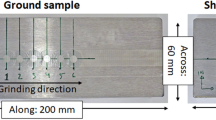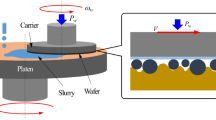Abstract
In order to improve the mechanical system performances such as wear resistance and vibration damping behavior, it was focused on the micro-topography of the surface machined by electro-chemical mechanical finishing (ECMF) in this paper. The ECMF was applied in this investigation as a result of it providing more controllable process parameters including the electric potential gradient (EPG), current density, mechanical force, and passive film. The simulation based on the finite element method was applied to analyze the influence of the EPG and the current density on the surface micro-topography under the different magnitudes of mechanical pressure and thicknesses of the passive film. It was shown that the mechanical pressure and the mass percent of the electrolyte which had been controlled are profitable and necessary to gain the feature of arc-like micro-topography on the surface and the growth in material removal rate. The unusual micro-topography of the surface with Ra0.2024μm was finished by using ECMF within 2 min on the condition of 20% NaNO3 electrolyte and 0.2 MPa of mechanical pressure. The investigation on dynamic pressure effect was carried out to confirm the influence of the unusual micro-topography on the thickness in the oil film. The result indicated that compared with the surface machined by fine grinding (FG), the surface finished by ECMF can make an increase in the average film thickness of 3% and a reduction in the square deviation of 46.5%. A discussion was set up to determine the cause of the difference in the results of the experiment. It was shown that the reason for the difference is the distinction in the micro-topography of the surface obtained by ECMF and FG. The micro-topography of the surface finished by ECMF is more favorable to establish a stranger and stable dynamic pressure effect as the result of its fractal dimension, scale coefficient, kurtosis and skewness. The discussion indicated that the finish method impacts the surface topography, and the machining accuracy affects the cross-scale effect of the surface dynamic pressure effect.












Similar content being viewed by others
Data Availability
The raw data required to reproduce these findings cannot be shared at this time as the data also forms part of an ongoing study.
References
WANG J, WANG X (2015) State of the art in innovative design of surface texture. J Mech Eng 51(23):84–95. https://doi.org/10.3901/JME.2015.23.084
Hao L, Li L, Qiu C, Wang J, Zhou X, Kang Y (2019) Texture development and properties of Ti-IF steels produced by different hot-rolling processes. J Iron Steel Res Int 26:310–320. https://doi.org/10.1007/s42243-018-0182-4
Xue B, Geng Y, Wang D, Sun Y, Yan Y (2019) Improvement in surface quality of microchannel structures fabricated by revolving tip-based machining. Nanomanuf Metrol 2:26–35. https://doi.org/10.1007/s41871-018-0032-9
Wang D, Zhang X, Zhang D (2018) Fabrication of a peristome surface structure of Nepenthes alata by elliptical vibration cutting. Nanomanuf Metrol 1:209–216. https://doi.org/10.1007/s41871-018-0022-y
Ruan M, Li W, Wang B, Deng B, Ma F, Yu Z (2013) Preparation and anti-icing behavior of superhydrophobic surfaces on aluminum alloy substrates. Langmuir 29:8482–8491. https://doi.org/10.1021/la400979d
Sun J, Cheng W, Song J, Lu Y, Sun Y, Huang L, Liu X, Jin Z, Carmalt CJ, Parkin IP (2018) Fabrication of superhydrophobic micro post array on aluminum substrates using mask electrochemical machining. Chin J Mech Eng 31:72. https://doi.org/10.1186/s10033-018-0270-1
Tang Y, Zhou M, Han Z, Wan Z (2010) Recent research on manufacturing technologies of functional surface structure. J Mech Eng 46(23):93–105. https://doi.org/10.3901/JME.2010.23.093
Song J, Huang W, Liu J, Huang L, Lu Y (2018) Electrochemical machining of superhydrophobic surfaces on mold steel substrates. Surf Coat Technol 344:499–506. https://doi.org/10.1016/j.surfcoat.2018.03.061
Song J, Huang S, Hu K, Lu Y, Liu X, Xu W (2013) Fabrication of superoleophobic surfaces on al substrates. J Mater Chem A 1(46):14783–14789. https://doi.org/10.1039/c3ta13807k
Tang W, Zhou Y, Zhu H, Yang H (2013) The effect of surface texturing on reducing the friction and wear of steel under lubricated sliding contact. Appl Surf Sci 2013(273):199–204. https://doi.org/10.1016/j.apsusc.2013.02.013
Mohammad AEK, Wang D (2016) Electrochemical mechanical polishing technology: recent developments and future research and industrial needs. Int J Adv Manuf Technol 86:1909–1924. https://doi.org/10.1007/s00170-015-8119-6
Yu H, Huang W, Wang X (2013) Dimple patterns design for different circumstances. Lubr Sci 25:67–78. https://doi.org/10.1002/ls.168
Wang Z, Mo J, Chen G, Shao T, Zhu M, Zhou Z (2013) Mechanism of the effect of groove-textured surface on the friction vibration and noise. J Mech Eng 49(23):112–116. https://doi.org/10.1016/j.wear.2013.01.082
Wang Y, Hu H, Shao J, Ding Y (2014) Fabrication of well-defined mushroom-shaped structures for biomimetic dry adhesive by conventional photolithography and molding. Acs Appl Mater Interf 6(4):2213–2218. https://doi.org/10.1021/am4052393
Zhou S, Adayi X (2018) Research on influence of friction surface micro-topography on the integration, transmission and its action of micro-dynamic pressure effect. J Mech Eng 54(21):120–126. https://doi.org/10.3901/JME.2018.21.120
Simon J, Sabeur M, Mohamed EIM, Benoit J (2015) Dependence of tooth flank finishing on powertrain gear noise. J Manuf Syst 37(2):467–471. https://doi.org/10.1016/j.jmsy.2014.11.006
Wang X (2002) The mechanism and surface characteristic of pulse electrochemical and its compounded finish machining. Dissertation, Dalian University of Technology
Xu W, Wei Z, Sun J, Wei L, Yu Z (2012) Surface quality prediction and processing parameter determination in electrochemical mechanical polishing of bearing rollers. Int J Adv Manuf Technol 63:129–136. https://doi.org/10.1007/s00170-011-3891-4
Pang G (2011) Surface quality and accuracy characteristics of cylindrical gears by generative electrochemical-mechanical finishing. J Mech Eng 47(19):163–167. https://doi.org/10.3901/JME.2011.19.163
Chen Y, Zhu S, Lee S, Wang J (2003) The technology combined electro-chemical mechanical polishing. J Mater Process Technol 140(3):203–205. https://doi.org/10.1016/S0924-0136(03)00826-4
Tranchida G, Clesi M, Franco FD, Quarto FD, Santamaria M (2018) Electronic properties and corrosion resistance of passive films on austenitic and duplex stainless steels. Electrochim Acta 273:412–423. https://doi.org/10.1016/j.electacta.2018.04.058
Li K (2017) Study on electrochemical gringing of high chromium alloy. Dissertation, Dalian University of Technology
Mao H, Jiao L, Gao S, Yi J, Peng Z, Liu Z, Yan P, Wang X (2017) Surface quality evaluation in meso-scale end-milling operation based on fractal theory and the Taguchi method. Int J Adv Manuf Technol 91:657–665. https://doi.org/10.1007/s00170-016-9708-8
Wang Q, Liang Z, Wang X, Zhou T, Zhao W, Wu Y, Jiao L (2016) Investigation on surface formation mechanism in elliptical ultrasonic assisted grinding (EUAG) of monocrystal sapphire based on fractal analysis method. Int J Adv Manuf Technol 87:2933–2942. https://doi.org/10.1007/s00170-016-8700-7
Luo G, Ming W, Zhang Z, Liu M, Li H, Li Y, Yin L (2014) Investigating the effect of WEDM process parameters on 3D micron-scale surface topography related to fractal dimension. Int J Adv Manuf Technol 75:1773–1786. https://doi.org/10.1007/s00170-014-6271-z
Kartuzov VV, Dmitrishina YY (2015) Multi-fractal analysis of the microstructures of aluminum alloys subjected to electrohydropulse treatment. Surf Engin Appl Electrochem 51:133–137. https://doi.org/10.3103/S1068375515020064
Funding
This research was supported by the National Natural Science Foundation of China (Grant No. 52665056).
Author information
Authors and Affiliations
Contributions
J.L. and X.A. conceived the research and designed the experiments. X.A. supervised the research. J.L. carried out the experiments. All authors analyzed and interpreted the data and wrote the paper.
Corresponding author
Ethics declarations
Competing interests
The authors declare that they have no conflict of interest.
Ethical approval
Not applicable
Code availability
Not applicable
Consent to participate
Not applicable
Consent for publication
Not applicable
Additional information
Publisher’s note
Springer Nature remains neutral with regard to jurisdictional claims in published maps and institutional affiliations.
Rights and permissions
About this article
Cite this article
Liu, J., Adayi, X. Effect of mechanical action and passive film on electrochemical mechanical finishing. Int J Adv Manuf Technol 112, 1787–1795 (2021). https://doi.org/10.1007/s00170-020-06510-4
Received:
Accepted:
Published:
Issue Date:
DOI: https://doi.org/10.1007/s00170-020-06510-4




